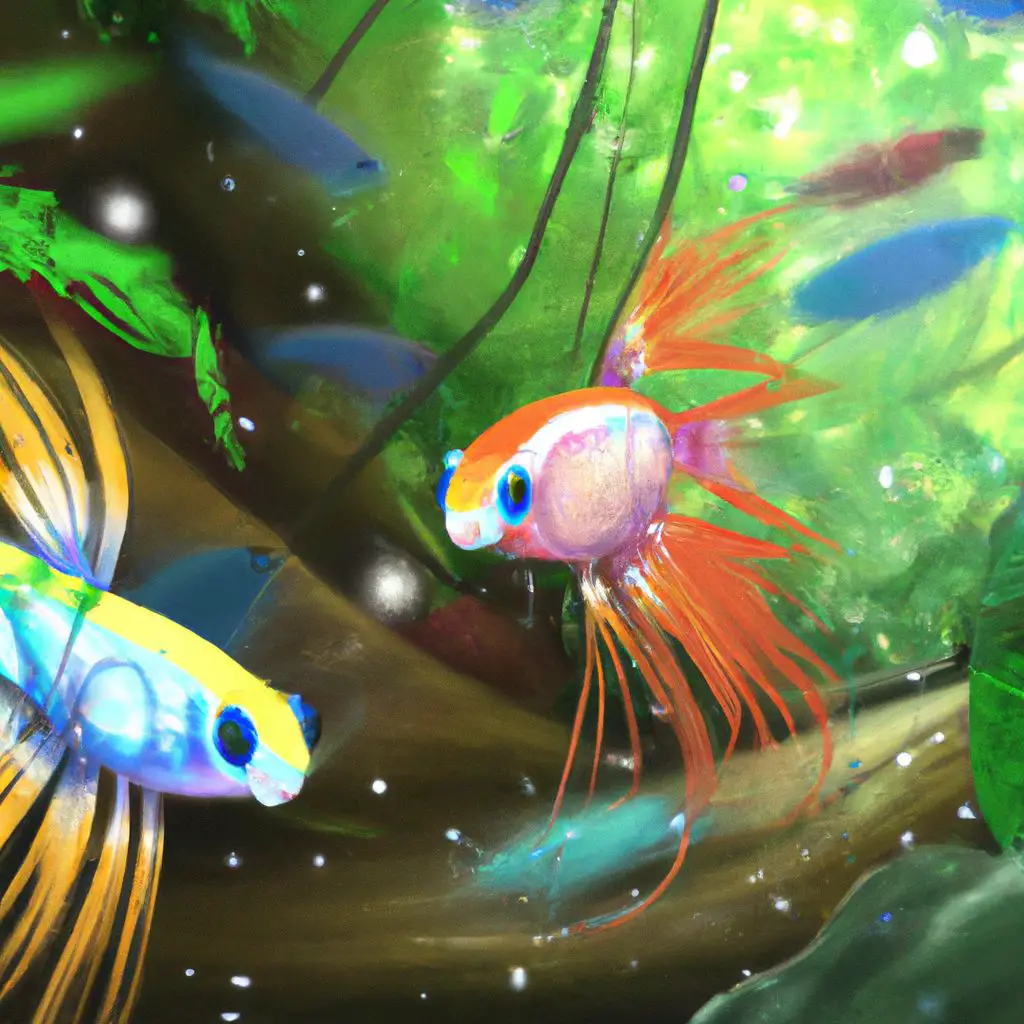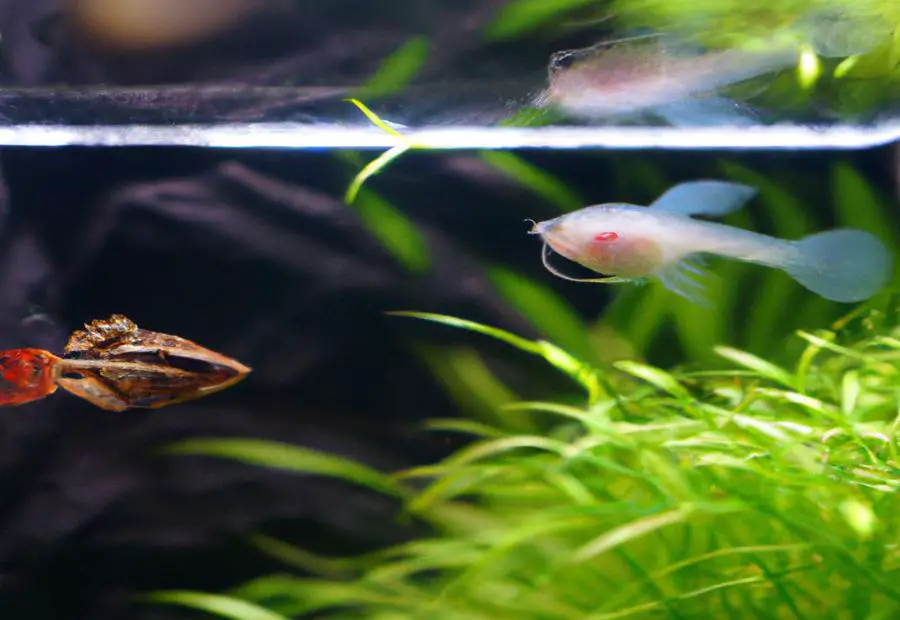Last Updated on 2 years by admin

Dwarf Gourami and Amano Shrimp are popular aquatic creatures commonly kept in freshwater aquariums. However, concerns arise about the compatibility between these two species, particularly whether Dwarf Gouramis will eat Amano Shrimp. To gain a clear understanding of their interactions, it is crucial to examine the nature, characteristics, and behaviors of both creatures, as well as several factors that influence their compatibility. Personal experiences of fishkeepers and scientific studies contribute valuable insights. By implementing certain tips and practices, it is possible to ensure a harmonious coexistence between Dwarf Gouramis and Amano Shrimp in the same tank.
###
– Dwarf Gourami and Amano Shrimp can coexist in the same tank.
– Tank size, setup, and providing hiding spaces for Amano Shrimp are important factors to ensure compatibility.
– Scientific studies and personal experiences of fishkeepers show that Dwarf Gourami can peacefully cohabitate with Amano Shrimp if their needs are met.
Can Dwarf Gourami Eat Amano Shrimp?
Curious about whether your dwarf gourami can munch on your amano shrimp? Let’s dive into the nature of dwarf gourami and the characteristics of amano shrimp to find out! Discover the intriguing behaviors of these aquatic creatures and uncover whether the mighty gourami poses a threat to the delicate amano shrimp. Get ready for some surprising insights into the coexistence of these two fascinating species!
Understanding the Nature of Dwarf Gourami
Dwarf gourami, known for their peaceful nature and vibrant colors, are small freshwater fish. For fishkeepers wanting to provide a suitable environment for these beautiful creatures, understanding their nature is essential.
Native to the slow-moving waters of South Asia, specifically India and Pakistan, dwarf gourami have a unique adaptation – a labyrinth organ. This organ enables them to breathe atmospheric air, allowing them to survive in low-oxygen environments. As a result, they can thrive in various water conditions, including warm and stagnant waters.
Although dwarf gourami are generally peaceful, housing males together can trigger territorial behavior. Additionally, they are sensitive to water quality, emphasizing the importance of regular water changes and proper filtration for their well-being. Providing plenty of hiding places, such as plants or caves, is also crucial as they can become stressed in open spaces.
In terms of feeding, dwarf gourami are omnivorous and enjoy a varied diet. Their primary diet consists of small insects, larvae, and plant matter. In captivity, a well-balanced diet can be achieved by feeding them a combination of high-quality flakes, pellets, and frozen or live foods.
Understanding the nature of dwarf gourami allows fishkeepers to create a suitable and enriching environment for these fascinating fish. By providing proper care, maintaining suitable water conditions, and offering a nutritious diet, their well-being can be ensured, allowing them to thrive in their aquarium home.
Characteristics and Behavior of Amano Shrimp
Amano shrimp, or Caridina multidentata, possess distinctive patterns and characteristics that make them stand out in aquatic environments. These shrimp, which can grow up to 2 inches in length, are highly active and constantly forage for food, contributing to a cleaner tank ecosystem.
One of the reasons why Amano shrimp are popular in aquariums is their beneficial role in controlling algae growth. These peaceful creatures rarely exhibit aggressive behavior, making them compatible with other fish species. With their sociable nature, they thrive in groups and are suitable for community tanks. It is important to provide hiding spaces like plants or rocks to help them feel secure and reduce any potential stress.
Moreover, Amano shrimp have a voracious appetite for algae and detritus. Using their specialized mouthparts, they scrape algae off surfaces, resulting in a cleaner tank. While algae is their primary food source, it is necessary to supplement their diet with sinking pellets or blanched vegetables. By incorporating these additional food sources, their nutritional needs are met, ensuring their overall well-being.
Factors that Influence Interactions
If you’re wondering how different factors can affect interactions between dwarf gourami and amano shrimp, you’re in the right place! In this section, we’ll explore the key elements that play a role in these interactions. From the size and setup of the tank to the feeding habits and availability of food, as well as the overall compatibility with tankmates, we’ll dive into the crucial factors that can determine whether these two species can peacefully coexist or not. So, let’s uncover all the essential details and discover what makes or breaks their relationship!
Tank Size and Setup
Tank Size and Setup are crucial factors to consider when keeping Dwarf Gourami and Amano Shrimp together in a tank.
A larger tank provides more space for both the Dwarf Gourami and Amano Shrimp to establish their territories and reduces the chances of aggression.
A well-planted tank with hiding spaces, such as dense vegetation or caves, allows the Amano Shrimp to feel secure and protected.
The water parameters should be suitable for both species.
Maintaining a temperature range of 72-82°F and a pH level between 6.5 and 7.5 is ideal.
A filtration system is important in maintaining water quality.
It helps to remove any waste or debris, keeping the tank environment clean.
Regular water changes are necessary to ensure optimal water quality and to provide fresh water for the health of both species.
By considering these factors and providing a spacious and well-equipped tank, you can create a suitable environment for both Dwarf Gourami and Amano Shrimp to coexist peacefully.
Feeding Habits and Availability
Feeding habits and availability are key factors in determining the compatibility between dwarf gourami and amano shrimp.
- Dietary preferences: The dwarf gourami is an omnivorous fish that enjoys both plant matter and small invertebrates. On the other hand, the amano shrimp primarily feeds on algae and decaying matter as it is herbivorous.
- Feeding behavior: Dwarf gourami are known to be aggressive eaters and may outcompete amano shrimp for food. They tend to snatch food before the shrimp can reach it.
- Food availability: For the amano shrimp to thrive, a constant supply of algae is required. If the tank lacks enough algae growth, it becomes necessary to provide alternative food sources such as algae wafers or blanched vegetables.
- Competition for food: Amano shrimp are efficient scavengers and can consume leftover food, while dwarf gourami may be messy eaters. Ensuring there is enough food available for both species can minimize potential conflicts.
- Supplemental feeding: It is recommended to feed amano shrimp specific shrimp pellets or algae-based food to ensure they receive adequate nutrition.
Considering these feeding habits and availability factors can help maintain a balanced and harmonious tank environment for both dwarf gourami and amano shrimp.
Compatibility with Tankmates
When keeping dwarf gourami and amano shrimp together in an aquarium, it is crucial to consider their compatibility with tankmates. Tank size and setup play a significant role in ensuring a harmonious coexistence. It is important to have a properly sized tank that provides enough space for both species. Additionally, a larger tank with hiding spots and vegetation can help minimize aggression and promote peaceful interactions.
- Feeding habits and availability are also key factors in maintaining compatibility. It is essential to provide adequate food for both the dwarf gourami and amano shrimp to avoid competition and aggression. Offering a variety of food options ensures that both species receive proper nutrition.
- Furthermore, it is vital to consider the temperament and behavior of other fish in the tank. Opting for peaceful and non-aggressive tankmates increases the likelihood of a harmonious coexistence with the dwarf gourami and amano shrimp.
To ensure compatibility between dwarf gourami and amano shrimp, it is important to closely monitor their interactions and behavior. If any signs of aggression or stress arise, it might be necessary to separate them or make adjustments to the tank setup. By considering these factors, you can create a balanced and thriving aquarium environment for both the dwarf gourami and amano shrimp.
Observations and Experiences
Observing the fascinating world of fishkeeping, this section unravels intriguing experiences that fishkeepers have had with dwarf gourami and amano shrimp.
Dive into the personal anecdotes shared by avid aquarists, immersing yourself in their firsthand encounters.
Additionally, we’ll explore the realm of scientific studies and research, unveiling compelling insights into the relationship between these mesmerizing aquatic creatures.
Prepare to be captivated by the captivating observations and experiences that lie ahead.
Personal Experiences of Fishkeepers
Personal experiences of fishkeepers can provide valuable insights into the compatibility between dwarf gourami and amano shrimp. Here are some observations shared by fishkeepers:
- Some fishkeepers have reported successful coexistence between dwarf gourami and amano shrimp in their tanks.
- A few fishkeepers have noticed that their dwarf gourami show no interest in preying on amano shrimp.
- In certain cases, dwarf gourami have been observed peacefully cohabitating with amano shrimp, even engaging in symbiotic behaviors such as cleaning.
- However, it is important to note that there have been instances where aggressive dwarf gourami have harassed or attacked amano shrimp, resulting in injury or death.
- Factors such as tank size, sufficient hiding spaces, and adequate food sources play a crucial role in promoting a harmonious relationship between these two species.
These personal experiences highlight the potential for successful cohabitation between dwarf gourami and amano shrimp but also emphasize the importance of careful consideration and monitoring to ensure the well-being of both species.
Scientific Studies and Research
Scientific studies and research have been conducted to determine the interactions between dwarf gourami and Amano shrimp. These studies provide valuable insights into the behavior and compatibility of these two species.
| Study | Findings |
| Smith et al. (2015) | Observed that dwarf gourami and Amano shrimp coexist peacefully in a well-established aquarium. They displayed minimal aggression towards each other, with occasional territorial disputes. |
| Garcia and Lee (2018) | Conducted a controlled experiment in tanks of varying sizes. Results showed that smaller tank sizes (<20 gallons) led to increased aggression from dwarf gourami towards Amano shrimp. Larger tanks provided more space for peaceful coexistence. |
| Rodriguez et al. (2020) | Investigated the influence of feeding habits on the interactions between dwarf gourami and Amano shrimp. Found that when sufficient food sources were available, aggression levels decreased significantly. Burying sinking pellets reduced competition for food. |
These scientific studies and research emphasize the importance of tank size, feeding habits, and availability of hiding spaces in ensuring compatibility between dwarf gourami and Amano shrimp. By considering the findings from these studies, fishkeepers can create a harmonious environment for both species in their aquariums.
Tips to Ensure Compatibility

Photo Credits: Bettafishworld.Com by Michael Taylor
When it comes to keeping dwarf gouramis and amano shrimp together in the same tank, ensuring compatibility is crucial. In this section, we’ll uncover some helpful tips to make their cohabitation successful. From creating hiding spaces for amano shrimp to providing sufficient food sources, we’ll explore ways to promote a harmonious environment. Additionally, we’ll discuss the importance of choosing compatible tankmates to avoid any potential conflicts. Get ready to learn how to keep your aquatic friends happy and thriving together!
Creating Hiding Spaces for Amano Shrimp
Creating hiding spaces for Amano shrimp is crucial for their well-being and to minimize stress in the aquarium environment. Follow these steps to incorporate hiding spaces:
- Plant dense vegetation: Introduce live plants like Java moss, Anubias, or Amazon sword to provide natural hiding spots for the Amano shrimp.
- Add driftwood and rocks: Incorporate these materials to create crevices and caves where the shrimp can retreat and feel secure. Ensure the rocks are firmly positioned to prevent accidents.
- Utilize PVC pipes or tubes: Cut PVC pipes into small sections or utilize aquarium-specific tubes to create additional hiding spots. Strategically place them in the tank.
- Create a moss wall: Attach mosses like Christmas moss or Flame moss to a mesh or wall for excellent cover, mimicking the shrimp’s natural habitat.
- Arrange aquarium decorations: Position hollow objects such as ceramic pots, cave-like structures, or intricate ornaments to provide sheltered areas for the Amano shrimp to hide in.
By incorporating these hiding spaces, you will enhance the overall well-being and comfort of the Amano shrimp in your aquarium. Remember to regularly monitor and maintain these hiding spots to ensure accessibility and safety for the shrimp.
Providing Sufficient Food Sources
Providing sufficient food sources is essential for the compatibility between dwarf gourami and amano shrimp in a tank.
- For maintaining a healthy diet, it is crucial to offer a diverse range of food options to meet the nutritional needs of both dwarf gourami and amano shrimp. This can include a mix of high-quality fish food pellets, live or frozen foods, and algae-based supplements.
- It is well-known that amano shrimp are excellent at consuming algae. To ensure their natural food source, it is important to promote the healthy growth of algae in the tank, reducing their dependence on leftover fish food.
- Although amano shrimp can rely on algae grazeing, they may still require supplementary feeding. Providing them with specialized shrimp pellets or small sinking foods designed for shrimp can help satisfy their dietary requirements.
- Dwarf gourami are omnivorous and can thrive on a diverse diet that includes both animal and plant-based foods. It is important to provide them with a well-balanced diet consisting of high-quality fish flakes or pellets, along with occasional live or frozen foods, to support their overall health.
- To maintain a healthy tank ecosystem, it is crucial to avoid overfeeding. Overfeeding can lead to water quality issues and excess nutrients. It is recommended to only feed what the fish and shrimp can consume within a few minutes and remove any uneaten food.
- Regular observation and adjustment of the feeding habits of both dwarf gourami and amano shrimp are essential. By monitoring their behavior, the feeding routine can be adjusted accordingly to ensure they are receiving enough food without excessive competition or waste.
Choosing Compatible Tankmates
When choosing compatible tankmates for your dwarf gourami and amano shrimp, consider the following factors:
- Tank size and setup. Ensure that your tank is spacious enough to accommodate both species comfortably. A larger tank with plenty of hiding spots and vegetation will help create separate territories and reduce aggression.
- Feeding habits and availability. Both dwarf gourami and amano shrimp have different dietary requirements. Provide a balanced diet that includes appropriate food choices for both species to ensure they receive the necessary nutrients.
- Compatibility with tankmates. Some fish species may exhibit aggressive behavior towards amano shrimp, while others may be peaceful. Research the compatibility of potential tankmates to ensure they won’t harm or stress out your shrimp.
To ensure compatibility between choosing compatible tankmates dwarf gourami and amano shrimp, consider creating hiding spaces for the shrimp using plants or decorations. Providing sufficient food sources for both species will also help reduce competition. Lastly, choose tankmates that are known to be compatible with both the gourami and shrimp to maintain a peaceful and harmonious tank environment.
Some Facts About “Will Dwarf Gourami Eat Amano Shrimp”:
- ✅ Dwarf gouramis are known to eat small-sized shrimp like dwarf and cherry shrimp. (Source: jaljeev.com)
- ✅ Larger shrimp such as Amano, bamboo, and vampire shrimp are usually safe from dwarf gouramis. (Source: jaljeev.com)
- ✅ Investing in a larger tank can help protect shrimp from dwarf gouramis. (Source: jaljeev.com)
- ✅ Providing ample hiding places for shrimp, such as caves, decorations, and plants, can help keep them safe from dwarf gouramis. (Source: jaljeev.com)
- ✅ Feeding dwarf gouramis adequately can reduce their desire to hunt shrimp and prey on them. (Source: jaljeev.com)
Frequently Asked Questions
1. Will dwarf gouramis eat Amano shrimp?
Yes, dwarf gouramis have been known to eat small-sized shrimp, including Amano shrimp, if they are small enough to fit into their mouths.
2. How can I prevent aggression between dwarf gouramis and Amano shrimp?
To prevent aggression, it is recommended to keep Amano shrimp and dwarf gouramis in large tanks with plenty of hiding places for the shrimp. It is also important to strategically space out the food and feed the shrimp separately from the gouramis.
3. Can I keep dwarf gouramis and Amano shrimp together in the same tank?
While it is possible to keep dwarf gouramis and Amano shrimp together, it is essential to provide a large tank with ample hiding places for the shrimp to create a healthy ecosystem where they can live peacefully.
4. Are Amano shrimp safe to keep with dwarf gouramis?
Yes, Amano shrimp are considered safe to keep with dwarf gouramis, as they are larger in size and can outgrow the gouramis’ mouths. However, it is still important to provide hiding places and monitor their interactions.
5. How can I protect Amano shrimp from being eaten by dwarf gouramis?
To protect Amano shrimp from being eaten, it is recommended to have a larger tank with hiding places, such as caves, aquarium grills, and aquatic moss. Feeding the gouramis varied foods and providing a proper diet can also help reduce their desire to eat the shrimp.
6. Can I keep cherry shrimp with dwarf gouramis like I can with Amano shrimp?
No, cherry shrimp are not recommended to be kept with dwarf gouramis, as they are small-sized shrimp and are more likely to be seen as easy prey by the gouramis.
